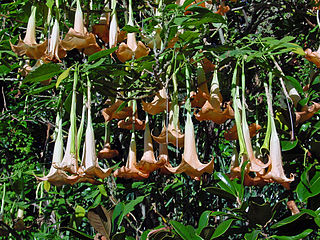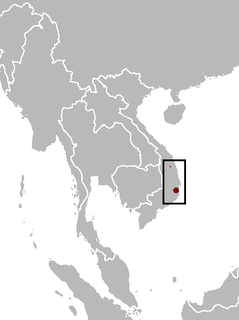
Chevrotains are small even-toed ungulates that make up the family Tragulidae, the only extant members of the infraorder Tragulina. The 10 extant species are placed in three genera, but several species also are known only from fossils. The extant species are found in forests in South and Southeast Asia, with a single species in the rainforests of Central and West Africa. They are solitary or live in pairs, and feed almost exclusively on plant material. Chevrotains are the smallest hoofed mammals in the world. The Asian species weigh between 0.7 and 8.0 kg, while the African chevrotain is considerably larger at 7–16 kg (15–35 lb).

White-fronted capuchin can refer to any of a number of species of gracile capuchin monkey which used to be considered as the single species Cebus albifrons. White-fronted capuchins are found in seven different countries in South America: Bolivia, Brazil, Colombia, Venezuela, Ecuador, Peru, and Trinidad and Tobago.

The gray treefrog is a species of small arboreal frog native to much of the eastern United States and southeastern Canada.

Cope's gray tree frog, also called the southern gray tree frog is a species of tree frog found in the United States. It is almost indistinguishable from the gray tree frog, and shares much of its geographic range. Both species are variable in color, mottled gray to gray-green, resembling the bark of trees. These are tree frogs of woodland habitats, though they will sometimes travel into more open areas to reach a breeding pond. The only readily noticeable difference between the two species is the mating call — Cope's has a faster-paced and slightly higher-pitched call than D. versicolor. In addition, D. chrysoscelis is reported to be slightly smaller, more arboreal, and more tolerant of dry conditions than D. versicolor.

Panulirus versicolor is a species of spiny lobster that lives in tropical reefs in the Indo-Pacific. Other names include painted rock lobster, common rock lobster, bamboo lobster, blue lobster, and blue spiny lobster. P. versicolor is one of the three most common varieties of spiny lobster in Sri Lanka, alongside Panulirus homarus and Panulirus ornatus.
Pristimantis versicolor is a species of frog in the family Craugastoridae.
Phrynobatrachus versicolor is a species of frog in the family Phrynobatrachidae. It is found in northwestern Burundi, western Rwanda, southwestern Uganda, and adjacent eastern Democratic Republic of the Congo. Common names Rwanda river frog and green puddle frog have been coined for it. The specific name versicolor, derived from the Latin versare and color, and refers to its variable dorsal colouration.

Psitteuteles is a genus of parrot in the family Psittaculidae.

The white-winged shrike-tanager is a species of bird in the family Thraupidae. It is found in Bolivia, Brazil, and Peru in subtropical or tropical moist lowland forests. Two subspecies are recognised, L. v. versicolor from eastern Peru, western Brazil and northern Bolivia, and L. v. parvus from eastern and central Brazil and northeastern Bolivia.
The versicolored monarch or Ogea monarch is a species of bird in the family Monarchidae. It is endemic to two islands, Ogea Driki and Ogea Levu, in the Lau Group of south eastern Fiji.

The versicolored barbet is a very colorful species of bird in the family Capitonidae. The species is also known as the blue-moustached barbet. It is found in humid Yungas forest growing on the east Andean slopes in Peru and Bolivia.

Tragulus is a genus of even-toed ungulates in the family Tragulidae that are known as mouse-deer. In Ancient Greek τράγος (tragos) means a male goat, while the Latin diminutive –ulus means 'tiny'. With a weight of 0.7–8.0 kg (1.5–17.6 lb) and a length of 40–75 cm (16–30 in), they are the smallest ungulates in the world, though the largest species of mouse-deer surpass some species of Neotragus antelopes in size. The mouse-deer are restricted to Southeast Asia from far southern China to the Philippines (Balabac) and Java. Following recent taxonomic changes, several of the species in this genus are poorly known, but all are believed to be mainly nocturnal and feed on leaves, fruits, grasses, and other vegetation in the dense forest undergrowth. They are solitary or live in pairs, and the males have elongated canine teeth that are used in fights. Unlike other members of their family, the Tragulus mouse-deer lack obvious pale stripes/spots on their upper parts.

Brugmansia versicolor is a species of plant in the family Solanaceae, commonly known as “angel’s trumpets”. They are endemic to Ecuador. Since March 2014, they have been listed as Extinct in the Wild by the IUCN.
Meriania versicolor is a species of plant in the family Melastomataceae. It is endemic to Colombia.
Symplocos versicolor is a species of plant in the family Symplocaceae. It is endemic to Sri Lanka.

The Vietnam mouse-deer, also known as the silver-backed chevrotain, is an even-toed ungulate in the family Tragulidae known only from Vietnam. It was first described in 1910 by British zoologist Oldfield Thomas, who procured four specimens from Nha Trang in Annam. Little is known about its distribution and ecology. After 1910, the Vietnam mouse-deer was reported next in 1990 near Dak Rong and Buon Luoi in the Gia Lai Province. With increasing hunting pressure, habitat loss due to deforestation and no more reports of the species in the wild, the mouse-deer was feared to have gone extinct. The IUCN listed the species as Data Deficient in 2008. In 2019, a study confirmed the presence of the Vietnam mouse-deer in dry low-lying forests of southern Vietnam with camera trap evidence. The mouse-deer is characterised by a rough coat with a strange double-tone coloration unseen in other chevrotains; the front part of the body is reddish brown and contrasts strongly with the greyish posterior. It has big reddish brown ears, white and dark reddish brown marks on the throat.
Malacoctenus versicolor, the Barfin blenny, is a species of labrisomid blenny native to the western Atlantic Ocean and the Caribbean Sea from southern Florida through the Antilles. It is an inhabitant of coral reefs preferring areas of rock or sand at depths of from near the surface to 7 metres (23 ft). This species can reach a length of 7.6 centimetres (3.0 in) TL.

Phrynocephalus versicolor, the variegated toadhead agama, is a species of agamid lizard found in desert areas of China and Mongolia. It was first described by the Russian herpetologist Alexander Strauch, director of the Zoological Museum at the Imperial Academy of Sciences at St. Petersburg.












